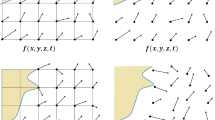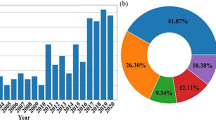Abstract
An upwind skewed radial basis function (USRBF)-based solution scheme is presented for stabilized solutions of convection-dominated problems over meshfree nodes. The conventional, radially symmetric radial basis functions (RBFs) are multiplied with an upwinding factor which skews the RBFs toward the upwind direction. The upwinding factor is a function of flow direction, intensity of convection, size of local support domain, and nodal distribution. The use of USRBFs modifies the weight values such that the necessary artificial diffusion is added only along the flow direction, whereas the crosswind diffusion is avoided. Subsequently, these skewed radial basis functions are employed in finite difference mode (RBF-FD) for derivative approximation. The performance and accuracy of the proposed scheme is studied by solving convection–diffusion problems over uniform and random distribution of meshfree nodes with various convection intensities. The upwinding effectively suppresses non-physical perturbation in numerical solution of convection-dominated problems. The results show that significant improvement in accuracy can be achieved by using the proposed USRBF-based solution scheme, particularly at higher convection intensities.

























Similar content being viewed by others
References
Liu G-R, Gu Y-T (2005) An introduction to meshfree methods and their programmin. Springer, New York. https://doi.org/10.1007/1-4020-3468-7
Javed A, Mazhar F, Shams TA, Ayaz M, Hussain N (2019) A stabilized RBF finite difference method for convection dominated flows over meshfree nodes. Eng Anal Bound Elem 107:159–167
Javed A, Djijdeli K, Xing J (2014) Shape adaptive RBF-FD implicit scheme for incompressible viscous navier–strokes equations. Comput Fluids 89:38–52. https://doi.org/10.1016/j.compfluid.2013.10.028
Javed A (2015) Investigation on meshfree particle methods for fluid structure interaction problems, Ph.D. thesis, University of Southampton
Javed A, Djijdeli K, Xing J (2016) A coupled meshfree-mesh-based solution scheme on hybrid grid for flow-induced vibrations. Acta Mech 227(8):2245–2274. https://doi.org/10.1007/s00707-016-1614-5
Javed A, Djidjeli K, Naveed A, Xing J (2018) Low reynolds number effect on energy extraction performance of semi-passive flapping foil. J Appl Fluid Mech 11(6):1613–1627
Sanyasiraju Y, Satyanarayana C (2013) On optimization of the RBF shape parameter in a grid-free local scheme for convection dominated problems over non-uniform centers. Appl Math Model 37(12–13):7245–7272. https://doi.org/10.1016/j.apm.2013.01.054
Golbabai A, Kalarestaghi N (2018) Improved localized radial basis functions with fitting factor for dominated convection–diffusion differential equations. Eng Anal Boundary Elem 92:124–135. https://doi.org/10.1016/j.enganabound.2017.10.008
Onate E, Idelsohn S, Zienkiewicz OC, Taylor RL (1996) A finite point method in computational mechanics. Applications to convective transport and fluid flow. Int J Numer Methods Eng 39(22):3839–3866. https://doi.org/10.1002/(SICI)1097-0207(19961130)39:22<3839::AID-NME27>3.0.CO;2-R
Oñate E (1998) Derivation of stabilized equations for numerical solution of advective–diffusive transport and fluid flow problems. Comput Methods Appl Mech Eng 151(1–2):233–265. https://doi.org/10.1016/S0045-7825(97)00119-9
Kansa EJ (1990) Multiquadrics—a scattered data approximation scheme with applications to computational fluid-dynamics—ii solutions to parabolic, hyperbolic and elliptic partial differential equations. Comput Math Appl 19(8–9):147–161. https://doi.org/10.1016/0898-1221(90)90271-K
Šarler B (2005) A radial basis function collocation approach in computational fluid dynamics. Comput Model Eng Sci 7:185–193. https://doi.org/10.3970/cmes.2005.007.185
Shu C, Ding H, Yeo K (2003) Local radial basis function-based differential quadrature method and its application to solve two-dimensional incompressible navier–stokes equations. Comput Methods Appl Mech Eng 192(7–8):941–954. https://doi.org/10.1016/S0045-7825(02)00618-7
Tolstykh A, Shirobokov D (2003) On using radial basis functions in a “finite difference mode” with applications to elasticity problems. Comput Mech 33(1):68–79. https://doi.org/10.1007/s00466-003-0501-9
Vertnik R, Šarler B (2006) Meshless local radial basis function collocation method for convective–diffusive solid–liquid phase change problems. Int J Numer Methods Heat Fluid Flow 16(5):617–640. https://doi.org/10.1108/09615530610669148
Shen Q (2010) Local RBF-based differential quadrature collocation method for the boundary layer problems. Eng Anal Bound Elem 34(3):213–228. https://doi.org/10.1016/j.enganabound.2009.10.004
Chinchapatnam PP, Djidjeli K, Nair P, Tan M (2009) A compact RBF-FD based meshless method for the incompressible navier–stokes equations. Proc Inst Mech Eng Part M J Eng Mar Environ 223(3):275–290
Sanyasiraju Y, Chandhini G (2008) Local radial basis function based gridfree scheme for unsteady incompressible viscous flows. J Comput Phys 227(20):8922–8948
Dehghan M, Mohammadi V (2015) The numerical solution of cahn-hilliard (ch) equation in one, two and three-dimensions via globally radial basis functions (GRBFs) and rbfs-differential quadrature (rbfs-dq) methods. Eng Anal Bound Elem 51:74–100. https://doi.org/10.1016/j.enganabound.2014.10.008
Versteeg HK, Malalasekera W (2007) An introduction to computational fluid dynamics: the finite, vol method. Pearson Education, London
Courant R, Isaacson E, Rees M (1952) On the solution of nonlinear hyperbolic differential equations by finite differences. Commun Pure Appl Math 5(3):243–255. https://doi.org/10.1002/cpa.3160050303
Warming R, Beam RM (1976) Upwind second-order difference schemes and applications in aerodynamic flows. AIAA J 14(9):1241–1249. https://doi.org/10.2514/3.61457
Leonard BP (1979) A stable and accurate convective modelling procedure based on quadratic upstream interpolation. Comput Methods Appl Mech Eng 19(1):59–98. https://doi.org/10.1016/0045-7825(79)90034-3
Patankar S (1980) Numerical heat transfer and fluid flow. CRC Press, Boca Raton
Brooks AN, Hughes TJ (1982) Streamline upwind/petrov-galerkin formulations for convection dominated flows with particular emphasis on the incompressible navier–stokes equations. Comput Methods Appl Mech Eng 32(1–3):199–259. https://doi.org/10.1016/0045-7825(82)90071-8
Whiting CH, Jansen KE (2001) A stabilized finite element method for the incompressible navier–stokes equations using a hierarchical basis. Int J Numer Meth Fluids 35(1):93–116. https://doi.org/10.1002/1097-0363(20010115)35:1<93::AID-FLD85>3.0.CO;2-G
Shu C, Ding H, Chen H, Wang T (2005) An upwind local RBF-DQ method for simulation of inviscid compressible flows. Comput Methods Appl Mech Eng 194(18–20):2001–2017. https://doi.org/10.1016/j.cma.2004.07.008
Gu Y, Liu G-R (2006) Meshless techniques for convection dominated problems. Comput Mech 38(2):171–182. https://doi.org/10.1007/s00466-005-0736-8
Kee BB, Liu G, Lu C (2007) A regularized least-squares radial point collocation method (RLS-RPCM) for adaptive analysis. Comput Mech 40(5):837–853
Fornberg B, Lehto E (2011) Stabilization of RBF-generated finite difference methods for convective pdes. J Comput Phys 230(6):2270–2285. https://doi.org/10.1016/j.jcp.2010.12.014
Chan Y, Shen L, Wu C, Young D (2014) A novel upwind-based local radial basis function differential quadrature method for convection-dominated flows. Comput Fluids 89:157–166. https://doi.org/10.1016/j.compfluid.2013.10.032
Chinchapatnam PP, Djidjeli K, Nair PB (2007) Radial basis function meshless method for the steady incompressible Navier–Stokes equations. Int J Comput Math 84(10):1509–1521
Micchelli CA (1984) Interpolation of scattered data: distance matrices and conditionally positive definite functions. In: Approximation theory and spline functions, Springer, New York, pp 143–145. https://doi.org/10.1007/978-94-009-6466-2_7
Haykin SS, Haykin SS, Haykin SS, Haykin SS (2009) Neural networks and learning machines, vol 3. Pearson, Upper Saddle River
Author information
Authors and Affiliations
Corresponding author
Additional information
Publisher's Note
Springer Nature remains neutral with regard to jurisdictional claims in published maps and institutional affiliations.
Rights and permissions
About this article
Cite this article
Javed, A., Baig, A.A., Djidjeli, K. et al. Upwind skewed radial basis functions (USRBF) for solution of highly convective problems over meshfree nodes. Engineering with Computers 37, 1081–1097 (2021). https://doi.org/10.1007/s00366-019-00873-3
Received:
Accepted:
Published:
Issue Date:
DOI: https://doi.org/10.1007/s00366-019-00873-3




